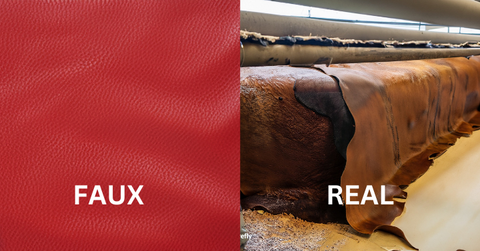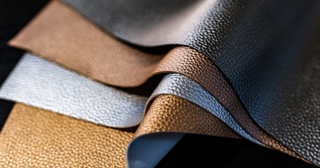When it comes to fashion, upholstery, and accessories, the choice between real leather and faux leather can be a real head-scratcher. Both materials have their merits and drawbacks, and the decision often boils down to personal preferences, ethics, and budget. In this article, we'll embark on a journey through the world of leather, unveiling the nuances between real and faux leather, and helping you make an informed choice.
The Leather Dilemma: A Tale of Two Textures

Leather: The Timeless Classic
Real leather, often hailed as the epitome of luxury and durability, is derived from animal hides, most commonly from cows. Its history dates back centuries, and it has remained a symbol of opulence and craftsmanship. Genuine leather leathers boasts a distinct, rich aroma and a texture that becomes more supple and attractive with age. The allure of real leather lies not only in its aesthetics but also in its ability to withstand the test of time.
Faux Leather: The Synthetic Contender
Faux leather, on the other hand, is an artificial creation designed to mimic the look and feel of genuine leather. It is typically made from polyurethane (PU) or polyvinyl chloride (PVC), both of which are synthetic materials. Faux leather is often championed for its affordability and versatility. It comes in various textures, colors, and finishes, making it a popular choice for those seeking animal-friendly alternatives.
The Battle of Qualities: Real vs. Faux Leather
Durability: The Tough Contestant
One of the primary factors that tilt the scales in favor of real leather is its durability. Genuine leather products are known to endure for decades, if not generations, with proper care. They can withstand wear and tear, making them an excellent choice for items like quilted leather jackets, boots, and sofas. The high quality of real leather is evident in its ability to age gracefully, developing a unique patina over time that enhances its appeal.
Faux Leather: The Challenger
Faux leather, while more budget-friendly, often falls short in the durability department. It might start to show signs of wear and tear relatively quickly, with cracks and peeling being common issues. However, advances in manufacturing have led to improved faux leather quality in recent years, with some higher-end varieties offering better longevity. It may not match the lifespan of real leather, but it can still provide value for those on a tighter budget.
Ethical Considerations: The Moral Compass
For many consumers, the decision between real and faux leather goes beyond aesthetics and durability. Ethical concerns regarding animal welfare play a significant role in this choice. Genuine leather is, by nature, a byproduct of the meat industry. While some view this as a sustainable use of resources, others find it objectionable and opt for faux leather as a cruelty-free alternative.
Faux Leather: The Ethical Choice
Faux leather is inherently cruelty-free, as it doesn't involve the use of animal hides. This makes it an appealing choice for individuals who prioritize animal welfare. However, it's essential to be discerning when selecting faux leather products, as the production of synthetic materials can also have environmental implications, especially if not made from eco-friendly materials.
The Price Tag: Real vs. Faux Leather
Real Leather: The Investment
Real leather often comes with a hefty price tag, and this is a significant consideration for many shoppers. Quality leather products can be quite expensive, and the price can vary based on factors such as the type of leather, craftsmanship, and brand. While it's undoubtedly an investment, the longevity and timeless appeal of real leather can make it a worthwhile expenditure for those with the means.
Faux Leather: The Budget-Friendly Option
Faux leather shines when it comes to affordability. It offers a wallet-friendly alternative for those who want the look and feel of leather without breaking the bank. This accessibility has made faux leather a popular choice for fashion enthusiasts and interior decorators working within a budget.
The Care and Maintenance: Real vs. Faux Leather
Real Leather: The High-Maintenance Beauty
While real leather has an edge in durability, it demands more care and attention to maintain its luster. Proper conditioning and occasional cleaning are essential to prevent cracking and preserve its natural oils. However, some people embrace the character that emerges as real leather ages, viewing it as a testament to its authenticity.
Faux Leather: The Low-Maintenance Darling
Faux leather, in contrast, is relatively low-maintenance. It doesn't require special leather conditioners or treatments. A simple wipe-down with a damp cloth is usually sufficient to keep it looking its best. This ease of care makes faux leather an attractive choice for those with busy lifestyles.
Faux Leather's Achilles' Heel: The Disadvantages
As we delve deeper into the realm of faux leather, it's crucial to acknowledge its disadvantages. While it offers affordability and ethics, it's not without its flaws. Here are some common drawbacks of faux leather:
- Durability Concerns: As mentioned earlier, faux leather tends to have a shorter lifespan than real leather, with issues like peeling and cracking.
- Breathability: Real leather allows air to circulate, making it more comfortable in hot weather. Faux leather lacks this breathability, which can lead to discomfort when worn for extended periods in warm conditions.
- Environmental Impact: While faux leather eliminates ethical concerns related to animal welfare, the production of synthetic materials can have negative environmental consequences. Many faux leather varieties are made from non-biodegradable materials like PVC, which can be harmful to the planet.
- Lack of Patina: Faux leather doesn't develop the unique patina that real leather does over time. Some people value this aging process as a testament to the authenticity of genuine leather.
Frequently Asked Questions
Which is better leather or faux leather?
The answer depends on your priorities. If you prioritize durability, authenticity, and don't have ethical concerns about animal products, real red leather jackets for men may be the better choice. On the other hand, if you seek affordability, ethical considerations, and versatility, faux leather is a viable alternative.
Is faux leather high quality?
Faux leather quality can vary widely depending on the manufacturing process and materials used. Higher-end faux leather products can offer decent quality and durability, but they may not match the longevity of genuine leather.
Is faux leather a good choice?
Faux leather can be an excellent choice for those on a budget or individuals who prioritize animal welfare. It offers affordability and versatility, making it suitable for a range of fashion and interior design applications.
What is 100% faux leather?
"100% faux leather" simply means that the material is entirely synthetic, containing no animal-derived components. It's an option for those who want to ensure their products are entirely cruelty-free.
Is faux leather 100% leather?
No, faux leather is not leather at all. It is a synthetic material designed to mimic the look and feel of real leather. It does not contain any animal hide.
What are the disadvantages of faux leather?
Faux leather has some drawbacks, including lower durability, lack of breathability, potential environmental impact, and the absence of the patina that real leather develops over time.
Is faux leather more expensive than leather?
Faux leather is generally more affordable than real leather. Genuine leather products tend to come with a higher price tag due to factors like material cost, craftsmanship, and brand reputation.
How long will faux leather last?
The lifespan of faux leather can vary depending on the quality of the material and how well it's cared for. Higher-quality faux leather products can last several years, but they typically have a shorter lifespan compared to genuine leather.
In the realm of leather, the choice between real and faux is far from black leather jackets and white leather jackets. It's a decision shaped by personal values, lifestyle, and budget constraints. Whether you opt for the timeless appeal of real leather or the versatility and affordability of faux leather, understanding the nuances between these materials empowers you to make a choice that aligns with your unique preferences. So, the next time you're faced with the leather dilemma, consider the factors that matter most to you, and make an informed decision that suits your style and values.


